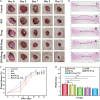Glycyrrhizic Acid Hydrogel Microparticles Encapsulated with Mesenchymal Stem Cell Exosomes for Wound Healing
- PMID: 39403257
- PMCID: PMC11471873
- DOI: 10.34133/research.0496
Glycyrrhizic Acid Hydrogel Microparticles Encapsulated with Mesenchymal Stem Cell Exosomes for Wound Healing
Abstract
Hydrogel microparticles have been proved to be curative to diabetic wounds. Current trends focus on the integration of bioactive matrix and their smart stimulus-responsive release to meet the complex demand of regeneration in diabetic wound. In this paper, we present novel stem cell exosome-encapsulated Chinese herb glycyrrhizic acid (GA) hydrogel microparticles for wound healing. The integrated GA endows the hydrogel microparticles with antibacterial properties, while the encapsulated exosomes impart them with pro-angiogenesis ability. In addition, as the black phosphorus is incorporated into these hybrid hydrogel microparticles, the release profile of GA and exosomes could be controllable under near-infrared irradiation due to the excellent photothermal effect of black phosphorus and the reversible phase transformation properties of GA. Based on these features, we have demonstrated that these microparticles can effectively kill bacteria, scavenge free radical, and promote angiogenesis from in vitro experiments. Besides, they could also markedly accelerate the wound healing process by down-regulating inflammation and promoting collagen deposition and angiogenesis in bacteria-infected in vivo diabetic wound. These results indicate that the proposed exosome-integrated GA hydrogel microparticles present great potential for clinical diabetic wound treatment.
Copyright © 2024 Luting Zhang et al.
Conflict of interest statement
Competing interests: The authors declare that they have no competing interests.
Figures






Similar articles
-
Engineering Bioactive Self-Healing Antibacterial Exosomes Hydrogel for Promoting Chronic Diabetic Wound Healing and Complete Skin Regeneration.Theranostics. 2019 Jan 1;9(1):65-76. doi: 10.7150/thno.29766. eCollection 2019. Theranostics. 2019. PMID: 30662554 Free PMC article.
-
Dual-functional gallium/chitosan/silk/umbilical cord mesenchymal stem cell exosome sponge scaffold for diabetic wound by angiogenesis and antibacteria.Int J Biol Macromol. 2024 Aug;274(Pt 2):133420. doi: 10.1016/j.ijbiomac.2024.133420. Epub 2024 Jun 24. Int J Biol Macromol. 2024. PMID: 38925194
-
A novel exosome-based multifunctional nanocomposite platform driven by photothermal-controlled release system for repair of skin injury.J Control Release. 2024 Jul;371:258-272. doi: 10.1016/j.jconrel.2024.05.049. Epub 2024 May 31. J Control Release. 2024. PMID: 38815704
-
Adipose-Derived Mesenchymal Stem Cell-Derived Exosomes Biopotentiated Extracellular Matrix Hydrogels Accelerate Diabetic Wound Healing and Skin Regeneration.Adv Sci (Weinh). 2023 Oct;10(30):e2304023. doi: 10.1002/advs.202304023. Epub 2023 Sep 15. Adv Sci (Weinh). 2023. PMID: 37712174 Free PMC article.
-
Injectable Self-Healing Adhesive Natural Glycyrrhizic Acid Bioactive Hydrogel for Bacteria-Infected Wound Healing.ACS Appl Mater Interfaces. 2023 Apr 12;15(14):17562-17576. doi: 10.1021/acsami.2c23231. Epub 2023 Mar 6. ACS Appl Mater Interfaces. 2023. PMID: 36877626
Cited by
-
Antimicrobial dual-crosslinked hydrogel synergizes bioengineered extracellular vesicles for enhanced diabetic wound healing.Mater Today Bio. 2025 May 13;32:101870. doi: 10.1016/j.mtbio.2025.101870. eCollection 2025 Jun. Mater Today Bio. 2025. PMID: 40487175 Free PMC article.
-
An injectable, self-healing, anti-infective, and anti-inflammatory novel glycyrrhizic acid hydrogel for promoting acute wound healing and regeneration.Front Bioeng Biotechnol. 2025 Jan 10;12:1525644. doi: 10.3389/fbioe.2024.1525644. eCollection 2024. Front Bioeng Biotechnol. 2025. PMID: 39867471 Free PMC article.
-
Dental follicle stem cell-derived small extracellular vesicles ameliorate pulpitis by reprogramming macrophage metabolism.Bioact Mater. 2025 May 12;51:179-196. doi: 10.1016/j.bioactmat.2025.04.034. eCollection 2025 Sep. Bioact Mater. 2025. PMID: 40475085 Free PMC article.
References
-
- Maschalidi S, Mehrotra P, Keçeli BN, De Cleene HKL, Lecomte K, Van der Cruyssen R, Janssen P, Pinney J, Loo G, Elewaut D, et al. . Targeting SLC7A11 improves efferocytosis by dendritic cells and wound healing in diabetes. Nature. 2022;606(7915):776–784. - PubMed
-
- Gao S, Rao Y, Wang X, Zhang Q, Zhang Z, Wang Y, Guo J, Yan F. Chlorella-loaded antibacterial microneedles for microacupuncture oxygen therapy of diabetic bacterial infected wounds. Adv Mater. 2024;36(15):2307585. - PubMed
-
- Theocharidis G, Yuk H, Roh H, Wang L, Mezghani I, Wu J, Kafanas A, Contreras M, Sumpio B, Li Z, et al. . A strain-programmed patch for the healing of diabetic wounds. Nat Biomed Eng. 2022;6(10):1118–1133. - PubMed
LinkOut - more resources
Full Text Sources

